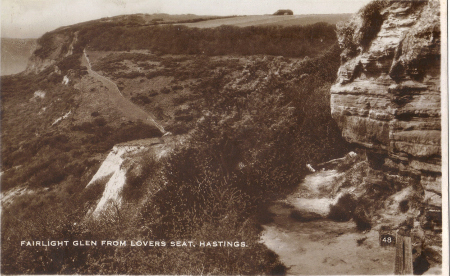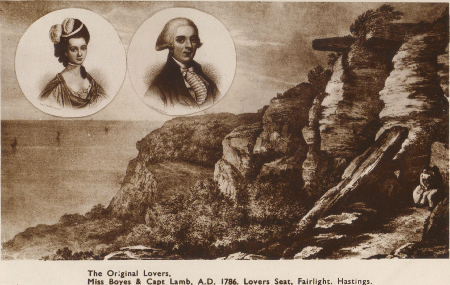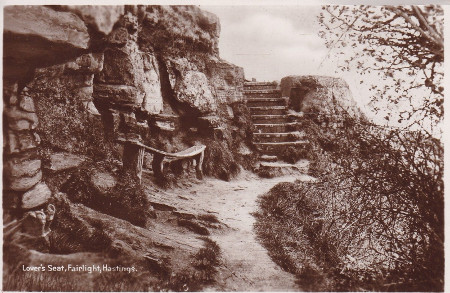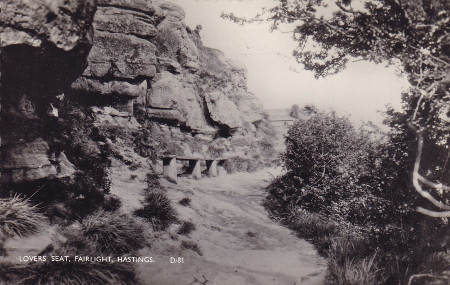Lovers’ Seat was shown on a map in the Hastings Guide in 1794 and many different stories about it have been written. Recorded facts do not bear out most of what is in these accounts and I propose here to leave it as a story that has served Hastings well as a tourist attraction. It is a shame that there in now nothing for visitors to see but I won’t dwell on that either.
The following account is from “A Londoner’s Holiday” HSLO 8th October 1870 reproduced from the City Press and I have chosen it because it is a little unique in that unlike the others it does not name the lovers as Elizabeth Boys and Charles Lamb.
THIS STORY OF LOVERS’ SEAT.
” The visitors at the Lovers Seat—a bare bench, painfully placed, at rather a giddy height, with the ocean salt bath at the bottom — had a rather primitive amusement afforded them. A healthy-looking, clean lad (though somewhat ragged), of twelve or fourteen years of age, assumed to himself the office of story- teller to the traditionary lovers. His views were very humble ; he was well satisfied with a fee of one half- penny from each listener. We will try to give an outline of his romantic tale. About one hundred years before the visit of Duke William to these parts, there was a mighty Baron who had six pairs of spurs and a tin helmet and a battle axe, six feet long and very sharp, who hoped to be King of Wessex, and was Lord of Fairlight, who among other treasures had one fair daughter ; and they christened her (girls had very long names then) the Honourable Mistress Cary Eva Ellen Scot (after Dun Scotus) Jerramite (after Jeremiah), and she was so pretty that when she walked abroad (in general her ladies maids carried her on their locked hands) all the bumpkins and bumpkinesses she met begged her to stand still, that they might look on her sweet face. She was very learned too ; she could read, make pothooks (some said she could cypher), play on the Jews’ harp, and sing like a lark. Well, she kept her bathing machine here. and so it was that a gallant sea captain used to watch her performances therein, and on several occasions saved her life when she got into deep water, and afterwards, as was right, they fell desperately in love, but the Baron would by no means suffer them to wed. So for secrecy they met every night at twelve o’clock ; they met on this very spot. At last they ran away to Gretna-green and were married. Then the wrathful Baron turned Cary Eva Ellen Scot out of doors, and she told the captain, and the captain took her on a sea voyage, but a storm came on and he was drowned in the Bay of Biscay. The chroniclers do not say how the lady escaped, but she returned to this bench to bewail herself, and, after long consideration of her evil case, she resolved to rejoin her captain by water, for, said she, ‘The eels shall wreathe around my white arms, and the shrimps and prawns shall waggle their tails in sorrow over my remains’ But while she thus determined, there was another sea captain watching over her, and when she cast herself into the sea, he followed her in full costume, and most gallantly rescued her from a briny grave. Of course, she went a second time to Gretna-green, and they lived happily ever after, cruising about to America, before it was discovered by Columbus ; to the Indies, and to Prester John’s country, only making a point to sit on this bench every month at full moon for an hour and forty minutes. From which remarkable circumstance, the spot has ever since been called The Lovers’ Seat. May you, dear ladies, be as fortunate as Dame Cary Eva Ellen Scot ; and your dear beaus and brothers resemble sea captain the second!”
And so on to Postcard 1 that does depict Elizabeth Boys and Charles Lamb. Date unknown, published by Shoesmith & Etheridge of Hastings. The portraits appear on souvenirs produced by T Ross of Claremont and other places but their authenticity does come into question when close examination reveals that the lithographic company responsible was not even in business when they were alive.
Postcard no 2 is the earliest photographic example I have found so far, postally dated 1902, publisher unknown. The seat itself, a rustic bench consisting of a plank on 4 supports.
Postcard no 3 is a Judges similar view to the previous, captioned “before the landslip of 1910”. The landslip was reported at the time to have taken place over a number of weeks, leaving just a “narrow ledge” in front of the seat and the “pleasantly wooded slope which once descended from the seat to the seashore has become a glacier of mud and rock”. The slab of rock seen to the left of the seat went down too. Judges had already published this card with the same serial number 119 and just added the caption. What was written on the sign is not known, but as except for one other, the numerous cards with the slab of rock to the left do not show the sign I think we may make the assumption that this was probably the most recent photo prior to the landslip.
Postcards 4 & 5 are post landslip showing first the view to the west and the steep slope that is now in front of the new fence. The other view looking east shows the new steps.
Well the fence didn’t last long, seems to be a Country Park tradition, here it is in Postcard 6, posted in 1914, already falling over. This card has many guises, some with just the 2 ladies, some as here with the 4 men at the top of the steps and others with the 4 men obviously drawn in by hand, both black and white and tinted.
Fence completely gone now and the seat looking decidedly tired in Postcard 7. However a very popular card though with again many guises, black and white, sepia and a variety of tints. Earliest postmark seems to be around 1924.
The seat apparently completely disappeared during the Second World War, “destroyed by the military”. Postcard 8 probably shows the very one, produced by publishers Excel who are said to only have been active during the years of 1935-55 and this one postally used in August 1939 narrows the date somewhat. The plank now seems to have been replaced by a couple of pieces of 4 x 2. This postcard is also of interest as on the skyline one can just make out the barn from whence Barn Pond got its name.

After the war the seat was replaced by the generosity of a Mrs L C Pridaux. This may be it in Postcard 9, postmarked September 1960. If the sender did visit the seat it would have probably been their last chance as it was fenced off for safety that December.
The following February it was lost due to landslip but an alternative site was established in March which lasted until swept away in a further fall in1979, seemly forever.







